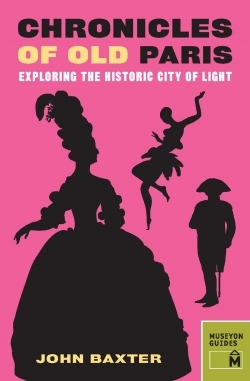Chronicles of Old Paris
Exploring the Historic City of Light
Coco Chanel spent her teens during the late 1900s in a convent, where she learned the useful trade of dressmaking. This experience provided the foundation for the legendary French couturier’s famed suits and “little black dresses.”
Chanel’s story is just one chapter in the book Chronicles of Old Paris: Exploring the Historic City of Light. This fascinating read contains twenty-nine chapters, each including a brief story, photos, illustrations, and often a map of the area of the city where the tale took place. While this is a nonfiction book, it reads like fiction, whereby the reader journeys through Paris at different times in its history, through the stories of famous people and places.
“Elle Est Partie! The Theft of the Mona Lisa” tells of the theft of the iconic painting from the Musee de Louvre in August, 1911. While the painting was ultimately found and the thief caught, the details of the heist and the mystery surrounding possible copies of the painting sold for a fortune make for a fascinating read.
Marie Antoinette, wife of King Louis XVI, and infamous for telling her starving subjects, “Let them eat cake,” was apparently innocent of that remark, according to Baxter. Was she also innocent of the many other wrongdoings for which she was accused and eventually executed in 1793? Many such stories have mysterious endings.
In each of these short, punchy thumbnail sketches, readers learn about people in Paris but also about its history over the past several centuries. Marcel Proust, the Marquis de Sade, Napoleon Bonaparte and Josephine, in addition to well-known and not so well-known authors, painters, architects, and courtesans, are among those presented. Who knew that the notorious guillotine was named after its designer, Dr. Joseph-Ignace Guillotin, a curiously staunch opponent of capital punishment?
At the end of a chapter on Jean Moulin, leader of the French resistance against the Nazi occupation, a page is devoted to memorials to Moulin. It tells where Moulin’s ashes are interred, indicates the building where the first meeting of the resistance committee took place, and describes the Musee Jean Moulin, where the French hero’s papers are on display. A map pinpoints those areas for tourists and Paris residents, as well as the armchair visitor.
The style of writing is crisp and newsy. Small enough to carry in one’s purse or briefcase, Chronicle of Old Paris can be opened during a lull, sitting in the doctor’s waiting room or riding a bus, and the reader treated to a fascinating tale about the famous and infamous City of Lights.
John Baxter is a biographer, film critic, novelist, and broadcaster. A resident of Paris since 1989, he has written several other books about his adopted city and is also the author of titles on the cinema.
Reviewed by
Penny Hastings
Disclosure: This article is not an endorsement, but a review. The publisher of this book provided free copies of the book and paid a small fee to have their book reviewed by a professional reviewer. Foreword Reviews and Clarion Reviews make no guarantee that the publisher will receive a positive review. Foreword Magazine, Inc. is disclosing this in accordance with the Federal Trade Commission’s 16 CFR, Part 255.

